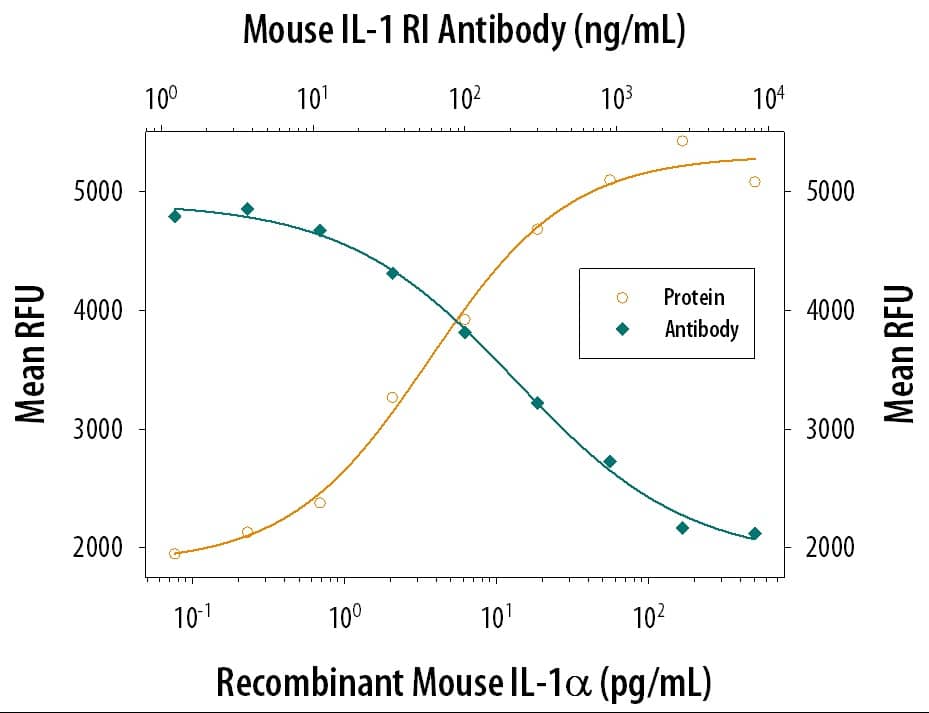Mouse IL-1 RI Antibody
R&D Systems, part of Bio-Techne | Catalog # MAB7711

Key Product Details
Species Reactivity
Validated:
Cited:
Applications
Validated:
Cited:
Label
Antibody Source
Product Specifications
Immunogen
Specificity
Clonality
Host
Isotype
Endotoxin Level
Scientific Data Images for Mouse IL-1 RI Antibody
Cell Proliferation Induced by IL‑1 alpha/IL‑1F1 and Neutral-ization by Mouse IL‑1 RI Antibody.
Recombinant Mouse IL-1a/IL-1F1 (Catalog # 400-ML) stimulates proliferation in the the D10.G4.1 mouse helper T cell line in a dose-dependent manner (orange line). Proliferation elicited by Recombinant Mouse IL-1a/IL-1F1 (50 pg/mL) is neutralized (green line) by increasing concentrations of Mouse IL-1 RI Monoclonal Antibody (Catalog # MAB7711). The ND50 is typically 0.05-0.15 µg/mL.Applications for Mouse IL-1 RI Antibody
Neutralization
Formulation, Preparation, and Storage
Purification
Reconstitution
Formulation
Shipping
Stability & Storage
- 12 months from date of receipt, -20 to -70 °C as supplied.
- 1 month, 2 to 8 °C under sterile conditions after reconstitution.
- 6 months, -20 to -70 °C under sterile conditions after reconstitution.
Background: IL-1 RI
Two distinct types of receptors that bind the pleiotropic cytokines IL-1 alpha and IL-1 beta have been described. The IL-1 receptor Type I is an 80 kDa transmembrane protein that is expressed predominantly by T cells, fibroblasts, and endothelial cells. IL-1 receptor Type II is a 68 kDa transmembrane protein found on B lymphocytes, neutrophils, monocytes, large granular leukocytes, and endothelial cells. Both receptors are members of the immunoglobulin superfamily and show approximately 28% sequence identity in their extracellular domains. The two receptor types do not heterodimerize into a receptor complex. Mouse IL-1 RI shares 63% amino acid sequence homology with human IL-1 RI in their extracellular domains.
An IL-1 receptor accessory protein (1) that can heterodimerize with the Type I receptor in the presence of IL-1 alpha or IL-1 beta, but not IL-1ra, was identified. This Type I receptor complex appears to mediate all the known IL-1 biological responses. The receptor Type II has a short cytoplasmic domain and does not transduce IL-1 signals. In addition to the membrane-bound form of IL-1 RII, a naturally-occurring soluble form of IL-1 RII has been described. It has been suggested that the Type II receptor, either as the membrane-bound or as the soluble form, serves as a decoy for IL-1 and inhibits IL-1 action by blocking the binding of IL-1 to the signaling Type I receptor complex. Recombinant IL-1 soluble receptor Type I is a potent antagonist of IL-1 action.
References
- Greenfeder, S. et al. (1995) J. Biol. Chem. 270:13757.
Long Name
Alternate Names
Gene Symbol
Additional IL-1 RI Products
Product Documents for Mouse IL-1 RI Antibody
Product Specific Notices for Mouse IL-1 RI Antibody
For research use only
